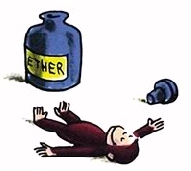
Okay, Curious George didn't really die from an overdose of ether. But after launching a blog reviewing children's picture books, I've discovered that some stories can be just as depressing!
1. The Jester Has Lost His Jingle
 | "Here I lie, I have a tumor... This book was written by a 22-year-old diagnosed with Hodgkin's disease, who died just before it was published. |
No one laughs at this jester's jokes in the castle, so he tries downtown, where he's confronted by the sight of a miserable homeless man. ("It's kind of hard to laugh or joke / when you're unemployed and completely broke.") A man smoking a cigarette on a graffiti-covered subway explains to the jester that "The world is not a funny place. It's filled with pain and tears." And then the jester visits the hospital's cancer ward...
Eventually the jester brings a smile to a little girl's face — and then, to the entire city, as the unusual plot of author David Saltzman lurches to a happy ending.
Six months later, Saltzman was dead.
2. Fireboat
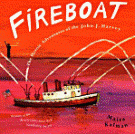
Fluffy bunnies? Happy little puppies? Nope. This children's picture book culminates with the terrorist attacks on the World Trade Center.
Maira Kalman emphasizes that on 9/11, two airplanes "CRASHED, CRASHED, CRASHED into these two strong buildings...." It's illustrated with a two-page watercolor showing a cloud of debris plummeting from the top of the tower, to help young readers visualize the impending carnage. Turn the page, and another two-page watercolor shows flames sweeping uncontrollably through the buildings at ground zero. And then there's another two-page spread, showing exactly what that same fire looked like that night.
They're not quite the cheery images you'd want to savor before bedtime. It's the climax of a story about the history of New York's famous fireboat, the John J. Harvey, which sprayed water on the burning towers all night with a volunteer crew. Which is why the book is called "Fireboat" — and why parents received no warning whatsoever that the book closes with the World Trade Center attacks until it surprises them in the book's final pages.
"Thanks for making me cry my head off in front of my child!!" wrote one reviewer on Amazon.
3. Rickie and Henri
"Unfortunately, Curious George's parents were both dead, since they'd already been shot in the head by local hunters."
That's basically the story Jane Goodall tells in Rickie and Henrie. Though she uses a real monkey instead of Curious George.
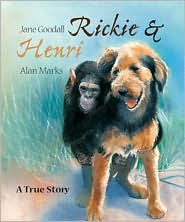
Based on a true story, Goodall's picture book describes a mother monkey who tenderly holds her little baby — a female monkey named Rickie. Rickie's mother carried her from place to place, and "comforted her when she was hurting or frightened." But in the next picture, Rickie is shown screaming beside her mother's dead body, as a man with a gun walks away.
And no, he's not wearing a yellow hat...
"The hunter seized Rickie and pushed her into a tiny basket, while the infant chimpanzee, who didn't understand, went on screaming and screaming for her mother." (Who does nothing, because she's already dead.) In the next illustration, the scared little monkey is locked in a cage on a pole, and she's already been wounded by shotgun pellets. But "however much she cried, there was no one to help."
Eventually the little female monkey is rescued and taken to Jane Goodall's institute and sanctuary. Where Goodall decided to write a very depressing children's picture book about her...
4. One Candle

|
A family gathers for their Hanukkah celebration. And then grandma starts reminiscing about Buchenwald...
"We were separated from our families and put into a camp," she says, remembering her experience as a 12-year-old girl in the Nazi death camps. |
The book explains the death camps as simply as possible. ("The Germans didn't like the Jews...") But another relative at the present-day Hanukkah celebration counters with a more nuanced perspective. "The Germans didn't like a lot of people. It wasn't only the Jews."
And then the flashback returns to the death camps....
5. On That Day
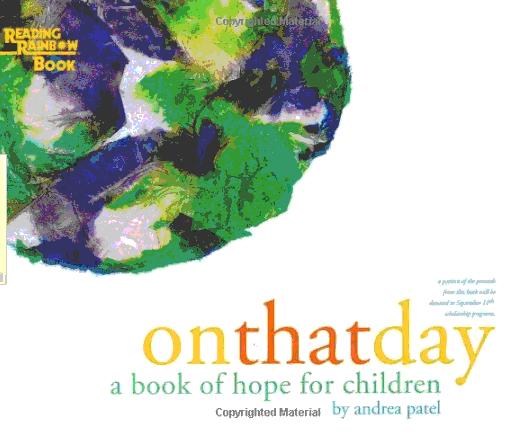
"Fireboat" may have covered the World Trade Center attacks, but at least it wasn't done with a tissue paper collage. Because ironically, that had already been done by Andrea Patel, a Massachusetts schoolteacher — and pastry chef, and musician. She represents the earth as a big blue circle of tissue paper, then writes "One day a terrible thing happened," as a big red splotch appears on that circle.
"The world, which had been blue and green and bright and very big and really round and pretty peaceful, got badly hurt.
"Many people were injured. Many other people died. And everyone was sad."
Then she tries explaining terrorism to children — using more tissue paper collages. There's a tornado, an earthquake, and a fire — all bad things that happen naturally. "But sometimes bad things happen because people act in mean ways and hurt each other on purpose," she writes. "That's what happened on that day, a day when it felt like the world broke." Then there's a picture of the pieces of the world blowing away and drifting across the blank whiteness of the next page...
The book was finished within weeks of the September 11 attacks, and Patel donated all the book's proceeds to a 9/11 charity, but the whole exercise is still a little disturbing. People fumbled for the right response to the terrorist attacks, and in the end, this is probably Patel's most inadvertently honest sentence.
"This is scary, and hard to understand, even for grown-ups."
6. Smoky Nights
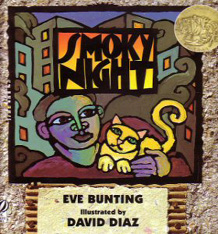 | It's the Los Angeles riots — through the eyes of a child.
What could possibly be more magical? "It can happen when people get angry..." a boy's mother says. "After a while it's like a game." The boy sees fires, and watches two men stealing a TV from an appliance store. Then another window breaks at a shoe store, and two men and a woman climb in through the broken glass. |
7. Michael Rosen's Sad Book
| "What makes me most sad is when I think about my son Eddie.
"He died." "I loved him very, very much but he died anyway." That's Michael Rosen, a British broadcaster, and his son died of meningitis in 2004 at the age of 19. "Sometimes this makes me really angry," Rosen writes in his book. (Its title? Michael Rosen's Sad Book.) "Maybe you think I'm happy in this picture. Really I'm sad but pretending I'm happy." | 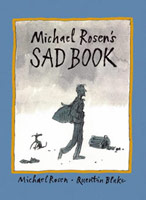 |
Rosen was 56 when the tragedy struck, and he's startlingly open about the experience of coping with a loss. Why is he smiling and pretending to be happy?
"I'm doing that because I think people won't like me if I look sad."
It's a depressing read, but it's also a brave moment of personal honesty. And maybe he's also sending us a message about depressing children's books.
Sometimes the truth can be very unpleasant...
See Also:
Lost "Horrors" Ending Found on YouTube
Six Freakiest Children's TV Rock Bands
Blossom Dearie's Conjunction Junction Romance?
How Gay Were the Hardy Boys?
Homeland Security Follies